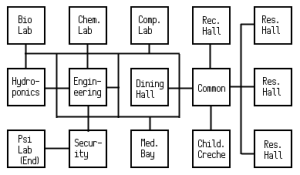In my last Designing with PGDI post, I answered some questions about the concept of My Childhood on the RS Anthony. These were questions about the tools I was using, the kind of control scheme I wanted, the perspective and look of the game. I also asked a slew of new questions to ask. These new questions were related to actual content for the game. Here I intend to answer those questions, or at least find a reasonable approximation.
To remind you, the questions raised last time are as follows:
- What obstacles will be placed in the player’s way?
- Determined by the obstacles, what abilities will we have?
- Direct abilities?
- Indirect abilities?
- What do these obstacles and abilities have to say about the way areas are constructed? (How are obstacles constructed?)
- Just what areas are in the game anyway?
- What are the finer details of the game? I.e., story bits like the macguffin that gives new abilities, who is running things, what do NPCs want from the player, etc.
Like the last post, I will take each question one at a time.
What obstacles will be placed in the player’s way?
This was a simple decision that I mostly made last post. I decided to have patrolling people, keypad-locked doors, cameras, and blockades.
Determined by the obstacles, what abilities will we have?
The abilities are divided into direct abilities and indirect abilities. Direct abilities do something to the obstacle at hand, while indirect abilities avoid the obstacle. For each obstacle, there is an ability of each. For the patrolling people, I have decided the direct ability to cause people to fall asleep for a few moments, allowing people to pass by. For the indirect ability, the ability to throw a ball of sound, which will sound when it hits a wall and attract people nearby.
Keypads, which lock doors, require a number to access. That number will always be kept by another person nearby. To directly operate the keypad, the player can use the automation ability, which will brute force the pad in rapid succession. This will take time. The indirect approach is to use the mind-reading ability, which will allow the player to extract the code from a character.
Cameras, as discussed before can be avoided, indirectly, by traveling on the ceiling. In this case, the ability is to reverse the player’s relationship to artificial gravity. Or, simply, a reverse gravity ability. The direct approach will simply be to use an EMP pulse ability, specifically on the power source of the camera which will be accessible to the player.
Blockades can be bypassed in two ways, over or around. The direct way is over, can be approached with a super jump ability, to get on top of the blockade and navigate it. Indirectly, the player can go through a maze of vents, low to the ground and short. To accomplish this, the player needs to use a shrinking ability.
How are obstacles constructed?
For people to be effective obstacles, there needs to be many corridors, which are narrow enough to patrol, but allow for the player to bypass a sleeping guard. Keypads are fairly easy to place next to any door that needs to be locked. Cameras need to be placed, angling down, in such a way that a player can slip by them on the ceiling, but the narrow corridors should suffice. Cameras should be sparse and only be in high security areas (hydroponics, security, and similar locations). Blockades are the most structural obstacle. Because we have a reverse gravity ability, the blockades need to block both the ceiling and the floor, but be open for people who can jump. There should also be vents, which usually go nowhere, but can get around areas that are blockaded.
Just what areas are in the game anyway?
For this, I have a list:
- Common Area – where some of the NPCs hang out.
- Children’s Creche – where the children live.
- Dining Hall – where some of the NPCs hang out.
- Recreation Center – where some of the NPCs hang out.
- Labs – Some of the NPCs will have you go here.
- Residences – Some of the NPCs will have you go here.
- Security – Some of the NPCs will have you go here.
- Hydroponics – Some of the NPCs will have you go here.
- Medical Bay – Some of the NPCs will have you go here.
- Engineering – Often an area between other areas.
- Psi Lab – Where the game ends.
- What are the finer details of the game?
I have also come up with a mockup.
What are the finer details of the game?
So the player doesn’t have a choice about getting new abilities, it should be administered by a parasite or something. So simply getting to an area is enough. The head researcher for the project should be the one running things, possibly someone who has been reported dead, from the first generation of researchers. NPCs will want fairly material things. They will know where those things are, but won’t go there. It usually involves theft or accessing places that are quarantined.
That’s it for this installment. I’m getting close to starting some design work in Unity to make this game. I think that I have enough details to actually start coding and getting something that is playable. It might be a while before I post on this at length again, but next time I might have some screen shots.
